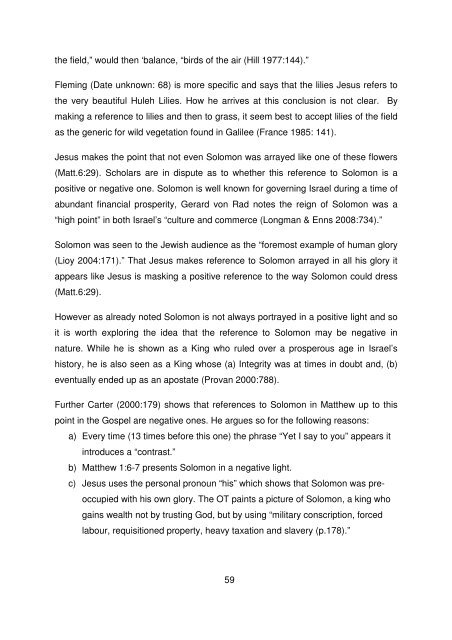O'Donoghue MTh_Thesis-FinalCopy.pdf - South African Theological ...
O'Donoghue MTh_Thesis-FinalCopy.pdf - South African Theological ...
O'Donoghue MTh_Thesis-FinalCopy.pdf - South African Theological ...
You also want an ePaper? Increase the reach of your titles
YUMPU automatically turns print PDFs into web optimized ePapers that Google loves.
the field,” would then ‘balance, “birds of the air (Hill 1977:144).”Fleming (Date unknown: 68) is more specific and says that the lilies Jesus refers tothe very beautiful Huleh Lilies. How he arrives at this conclusion is not clear. Bymaking a reference to lilies and then to grass, it seem best to accept lilies of the fieldas the generic for wild vegetation found in Galilee (France 1985: 141).Jesus makes the point that not even Solomon was arrayed like one of these flowers(Matt.6:29). Scholars are in dispute as to whether this reference to Solomon is apositive or negative one. Solomon is well known for governing Israel during a time ofabundant financial prosperity, Gerard von Rad notes the reign of Solomon was a“high point” in both Israel’s “culture and commerce (Longman & Enns 2008:734).”Solomon was seen to the Jewish audience as the “foremost example of human glory(Lioy 2004:171).” That Jesus makes reference to Solomon arrayed in all his glory itappears like Jesus is masking a positive reference to the way Solomon could dress(Matt.6:29).However as already noted Solomon is not always portrayed in a positive light and soit is worth exploring the idea that the reference to Solomon may be negative innature. While he is shown as a King who ruled over a prosperous age in Israel’shistory, he is also seen as a King whose (a) Integrity was at times in doubt and, (b)eventually ended up as an apostate (Provan 2000:788).Further Carter (2000:179) shows that references to Solomon in Matthew up to thispoint in the Gospel are negative ones. He argues so for the following reasons:a) Every time (13 times before this one) the phrase “Yet I say to you” appears itintroduces a “contrast.”b) Matthew 1:6-7 presents Solomon in a negative light.c) Jesus uses the personal pronoun “his” which shows that Solomon was preoccupiedwith his own glory. The OT paints a picture of Solomon, a king whogains wealth not by trusting God, but by using “military conscription, forcedlabour, requisitioned property, heavy taxation and slavery (p.178).”59
















